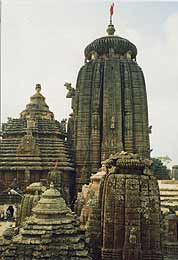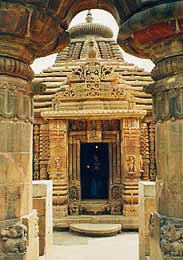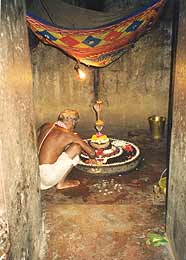 |
Bhubaneswar
is the capital of Orissa and is said to once have had 7,000 temples.
Now only a few hundred ancient temples remain. Most of the temples
are located near the Bindu-sarovara Tank, about 2km south of the
city center. They are all situated within a 3km (2 mile) area of
one another. Lingaraja and Vital Duel temples are located west of
the tank. Parasurameswar and Mukteswara temples are east of the
tank. |
 |
Lingaraja Temple (11th century)
The Lingaraja Temple is one of the most impressive and beautiful
temples in India. It is considered to be the pinnacle of Orissan
temple architecture. The main tower is 55m (180 feet) high. The
present temple was built between 1090 to 1104, but parts of the
temple are over 1400 years old.
|
 |
Tradition says that one should first visit this temple before
going to Puri. Sri Chaitanya Mahaprabhu came here before going
to Puri.
Non-Hindus are not permitted to enter the temple; and this rule
is strictly enforced. There is a 6m (20 ft) high viewing platform
along the northern wall of the temple, and from this vantage point
you can get a good view of the temple compound.
|
 |
The presiding deity is the
svayambhu linga, Hari-Hara Linga, which is half-Siva and half-Vishnu.
He is also named Tribhuvaneswara, the "Lord of the three worlds."
The linga of Lingaraja is an uncarved block of granite 2.5m (8 ft)
in diameter raised 20cm (8 inches) above the ground. The Siva linga
is bathed daily with water, milk, and bhang. There is a four-day
chariot festival every March-April when Lingaraja is drawn on his
chariot to the Rameswara Temple. There are also many other deities
residing in this temple. In the northeast corner there is Parvati. |
 |
Just nearby the Lingaraja Temple is Bindu-sarovara Tank.
It is said that Lord Siva established this tank as a place of
pilgrimage by bringing water from all the holy places. Taking
bath here and drinking the water of this lake is said to cure
stomach diseases. It is located immediately next to the Lingaraja
Temple. A pilgrimage to Bhubaneswar should be begun by bathing
at this spot. The Lingaraja deity is brought to the pavilion in
the middle of the tank and ritually bathed during the annual Car
Festival (Ashokastami). The best time to visit is around sunrise.
Sri Chaitanya took bath in this lake when he first came from Bengal
to Puri.
|
 |
On the eastern bank is the
Ananta Vasudeva Temple, dedicated to Krishna and Balarama. |
 |
Clay pots for cooking. |
 |
Entrance to the sanctum. |
 |
Mukteswara Temple
Built in the late 10th century, this small, elegant temple has been
described as the most exquisitely ornamented temple in Bhubaneswar.
Mukteswara means "the Lord who bestows freedom through yoga."
|
 |
It has an 11m (35 ft) high tower. The sandstone carvings are
this temple's most notable feature. It is known for its decorative
gateway, carved dwarves around the windows, and intricate motif
carvings of a smiling lion with beaded tassels in its mouth. On
the gate in front of the main entrance is a decorative gateway
(torana) complete with two reclining female figures.
The small Marichi Kund, between the Mukteswara Temple and the
road, is known to cure infertility in women. It is a pleasant
place to sit for awhile.
|
 |
As there is active worship
in many of the temples, it is best to dress conservatively. If a
temple priest shows you around a temple (with your consent), it
is appropriate to give a donation (approximately Rs 25). If you
look rich, they will ask for more (the sky is the limit). |
 |
Parasurameswar Temple
This temple is the oldest Siva temple in Bhubaneswar (built in the
late 7th century).
|
 |
Siva-lingam worshipped in
the temple. |
 |
It is full of intricate
carvings and is the best preserved and most impressive of the city's
early temples. It has carvings of elephant and horse processions
and all the windows are carved. On the east wall of the tower there
is an interesting carving of the marriage of Siva and Parvati. |
 |
In the corner of the courtyard
is the Sahasra-linga, 1,000 small lingas joined together. This temple
is close to the Bhubaneswar-Puri road, on the east side of Bindu-sarovara,
northeast of the Lingaraja temple. |
 |
There are also panels depicting
Lakulisha, a Shaivite, who helped revitalize Hinduism in Orissa
in the 5th century. He is seen on the west wall of the tower meditating
under the sculptures of Nataraj (dancing Siva), and on the east
wall with disciples at his feet. |
 |
Ramayana stories are still
popular in India. |
 |
Samdhi of Gaura Govinda Swami
Gaura Govinda Swami, a disciple of Srila Prabhupada, was preaching
Krishna consciousness in many place of the world and specifically
in Orissa, Bhubaneswar. He was respected scholar who translated
Prabhupada's books and established Krishna-Balarama Mandir thus
fulfilling one of the Prabhupada's desire. He departed this world
February 9, 1996 on the appearance day of Bhaktisiddhanta
Sarasvati while reciting the pastimes of Lord Sri Krishna. His
life and lectures remain the inspiration for many devotees and
disciples.
|

















